The Chinese Meteorological Society
Article Information
- TANG Jianzhao, WANG Jing, HE Di, HUANG Mingxia, PAN Zhihua, PAN Xuebiao . 2016.
- Comparison of the Impacts of Climate Change on Potential Productivity of Different Staple Crops in the Agro-Pastoral Ecotone of North China. 2016.
- J. Meteor. Res., 30(6): 983-997
- http://dx.doi.org/10.1007/s13351-016-6023-0
Article History
- Received March 16, 2016
- in final form June 11, 2016
2. (China Meteorological Administration Training Center, Beijing 100081);
3. (University of Chinese Academy of Sciences, Beijing 100049);
The agro-pastoral ecotone (APE) of North China is distributed across seven provinces and autonomous regions, and represents an intersection and transition zone of traditional agriculture and animal husbandry (Wu, 2003; Liu et al., 2009). The annual average precipitation of APE is less than 400 mm, with high interannual variability (Wang et al., 1999). Water shortage is a major limiting factor for crop production in APE (Zhao and Qiu, 2001; Pan et al., 2010; Xia et al., 2010), and soil fertility has also limited the level of improvement in crop yields due to poor soil conditions in the area (Zhang et al., 2011; Yang and Liu, 2014). How to increase the rainfall use efficiency and ensure stable crop yields under the warming climate is a key problem for agricultural production in APE (Hu et al., 2015). For several decades, growing more than one crop in a season in different fields has been a commonly applied cropping system method in this area, aimed at reducing the production risk of only planting a single crop in a large region (Duan et al., 2013; Hou et al., 2013). Staple crops in APE include sunflower (Helianthus annuus), potato (Solanumtuberosum), and spring wheat (Triticumaestivum Linn), which occupy 15.60%, 46.80%, and 24.40% of the total grain yield in this area, respectively. In recent years, the sown area of potato and sunflower has been increasing because of higher yields and drought tolerance compared with spring wheat (Hou et al., 2009). However, the climate adaptability of these three crops against the climate change background has rarely been investigated. Due to its unique geographical location and climate conditions, APE is highly sensitive to climate change, which has had significant impacts on crop production in this region (Qiu et al., 2001, Dong et al., 2012). Determining the impact of climate change on the potential productivity of staple crops can help in our understanding of the yieldlimiting factors involved, as well as guide appropriate measures to adapt to climate change (Wang et al., 2014). Crop potential productivity can be classified into four levels: photosynthetic, light-temperature, climate, and climate-soil potential productivity limited by light, light-temperature, light-temperature-precipitation, and light-temperature-precipitation-soil fertility under the control of insect pests and weeds, and optimal agricultural management (Huang, 1985; Li et al., 2010; Yuan et al., 2012; He et al., 2014). The gaps between the light-temperature and climatic potential productivity, the climate and climate-soil potential productivity reflect the yield loss due to water stress and soil fertility stress (He et al., 2014). A large number of studies have investigated crop potential productivity and potential productivity gaps by using mechanism-based empirical methods (Higgins et al., 1982; Ma and Guo, 1995; Wang et al., 2005; He et al., 2014), crop growth models (Lobell and OrtizMonasterio, 2006; Wang et al., 2012), and field experiments (Lobell et al., 2009).
In Northeast China, climate change has a negative impact on maize potential yield (Liu Z. J. et al., 2013; Lü et al., 2015). In the North China Plain, increased temperature and decreased radiation have led to a decrease in the potential yield of winter wheat and summer maize (Wang et al., 2012, 2014). In South China, the rice potential yield showed a decreasing trend between the 1980s and 2000s due to climate change (Liu L. L. et al., 2013). In Southwest China (SWC), the light-temperature and climatic potential productivity of maize has increased in the southwest of SWC but decreased in the northeast of SWC, caused by climate change, during the maize growing season (He et al., 2014). In contrast to the well-studied main grain production regions, the impacts of climate change on the potential productivity and productivity gaps of staple crops in APE remain almost untouched. Quantifying the potential productivity and productivity gaps of staple crops could help determine, in a targeted approach, the space and plant structure distribution required for certain crops in APE. Therefore, the objective of this study was to compare the spatiotemporal changes in climate variables during the crop growing season and their effects on the potential productivity, potential productivity gaps, and climate suitability of staple crops in APE during 1981-2010.
2Materials and methods 2.1Study sites and dataTwenty-seven sites roughly uniformly distributed across APE were selected for this study (Fig. 1). Staple crops at these sites include sunflower, potato, and spring wheat, with a single crop in one year. Climate data, including daily maximum temperature, minimum temperature, air pressure, precipitation, and sunshine hours were available from the China Meteorological Administration. Daily solar radiation was estimated from daily sunshine hours based on the Ångström equation (Wang et al., 2015). The major phenological phases of crops, including sowing, seedling, flowering, and maturity dates were recorded at the 12 agro-meteorological observation sites (Fig. 1), which were measured by well-trained agricultural technicians following a standardized observation method across the sites. The dates of the major phenological phases at other sites were based on the nearest agro-meteorological observation sites (Table 1).
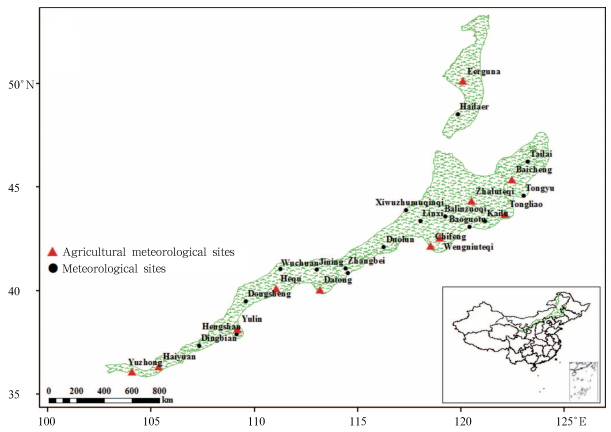
|
| Figure 1 The agro-pastoral ecotone (APE) region and the distribution of study sites. |
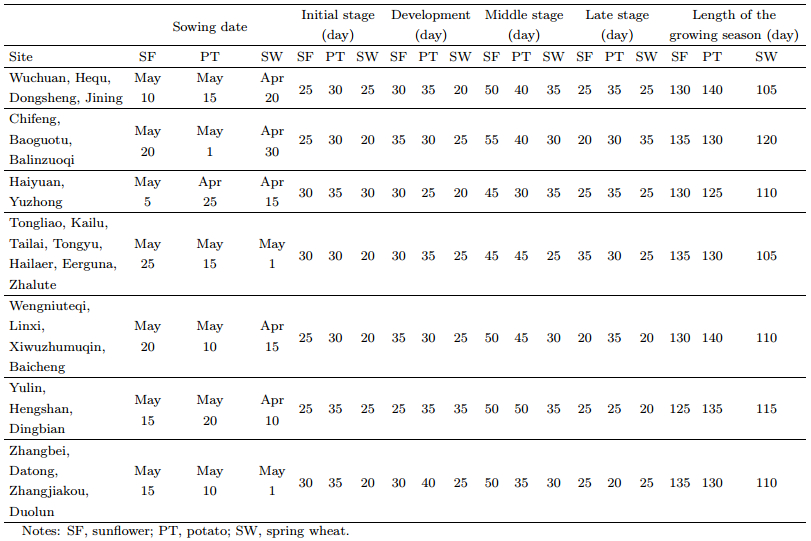
|
Soil data for each site, including soil type, soil organic carbon content, soil edaphic volume, level of gleyzation, level of pseudo-gleyzation, etc., were obtained from National Soil Survey Data (http://www.soil.csdb.cn/).
2.2Calculation of crop potential productivityThe photosynthetic, light-temperature, and climate-soil potential productivity of the staple crops in APE were calculated by using a crop growth dynamics statistical method (He et al., 2014). In order to compare with reported crop yields, the calculated crop potential productivity was converted to crop yield with a moisture content of 80% for potato, 9% for sunflower, and 13% for spring wheat.
2.2.1Photosynthetic potential productivityPhotosynthetic potential productivity (YQ, 103 kg ha-1) is the theoretical crop maximum productivity, which is calculated as follows (He et al., 2014):

|
(1) |
where 0.219 is the Huang Bingwei coefficient (10-5 kg kJ-1); C is the crop economic coefficient, taking the values of 0.39, 0.87, and 0.46 for sunflower, potato, and spring wheat, respectively (Zhang and Zhu, 1990); j represents each crop development stage; and gdj is the length of each development stage for crop (Table 1). Rs, i (kJ cm-2 day-1) is the daily shortwave radiation during the crop growing season, which is calculated as

|
(2) |
where Ra, i (kJ cm-2 day-1) is the daily extraterrestrial radiation; ni (h) is the daily actual duration of sunshine; Ni (h) is the daily maximum possible duration of sunshine; and as=0.25 and bs=0.50 are used for the estimation of Rs, i, as recommended by Allen et al. (1998).
2.2.1Light-temperature potential productivityLight-temperature potential productivity (YT) is calculated by correcting the photosynthetic potential productivity with the temperature stress coefficient as follows:

|
(3) |
where f(ti) is the temperature stress coefficient, which can be calculated as follows (Li et al., 2010):

|
(4) |
where ti is the daily average temperature (℃); and tb, to, and tc are the base, optimum, and ceiling temperatures, respectively, of each growing stage for the crops (Table 2; Porter and Gawith, 1999; Gou et al., 2012).
Climate-soil potential productivity (YW) is calculated by correcting the light-temperature potential productivity with the water stress coefficient and soil stress coefficient as follows (Li et al., 2010):

|
(5) |
where f(wj) is the water stress coefficient, which can be calculated as follows:

|
(6) |
where Pj (mm) is the total precipitation during each crop development stage, and ETc, j (mm) is the total crop water requirement during each development stage, which can be calculated as:

|
(7) |
where Kc, j is the crop coefficient at different development stages (Table 3; Sun et al., 2002; Du et al., 2014; Hu et al., 2015).
ET0, i is calculated by the FAO Penman-Monteith equation (Allen et al., 1998):

|
(8) |
where ET0, i (mm day-1) is the daily reference crop evapotranspiration, Rn (MJ m-2 day-1) is the net radiation, G (MJ m-2 day-1) is the soil heat flux, t (℃) is the daily average temperature at 2-m height, U2 (m s-1) is the wind speed at 2-m height, es (kPa) is the saturated vapor pressure, ea (kPa) is the actual water vapor pressure, ∆(kPa ℃-1) is the slope of the saturation vapor pressure versus temperature relationship, and γ (kPa ℃-1) is the psychrometric constant. ET0 is calculated in daily steps, and G is negligible in this study.
The parameter f(s) represents the soil stress coefficient, which is calculated as follows (Lacatusu and Lacatusu, 2011):

|
(9) |
where CIF is a complex indicator of soil fertility, calculated by the marking method (Eq. (10)); and CIFa and CIFm are the actual and theoretical maximum soil fertility indicators of the study site, respectively:

|
(10) |
where POi and PEp are the potentiating and penalty indicators related to soil fertility, respectively (Table 4). The potentiating and penalty indicators were divided into five levels; for the potentiating indicators, a score of 1-5 represented the soil fertility from low to high, and vice versa for the penalty factors. CIFa was the actual soil indicator based on observed soil data at the study sites, while CIFm was the theoretical maximum soil fertility indicator with the highest score for each indicator, except for observed annual precipitation and temperature, at the study sites.
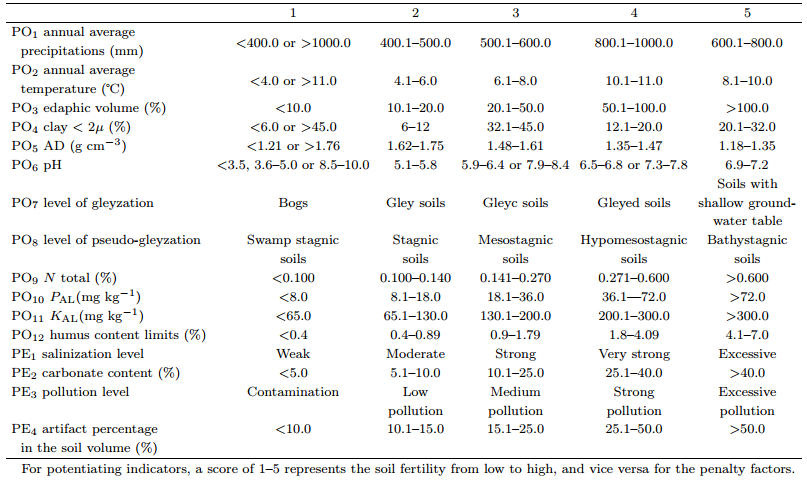
|
The climate suitability S(C) for the three crops, ranging from 0 to 1, was calculated as follows (Zhao et al., 2003):

|
(11) |
where aj is the weighting coefficient of each development stage in the whole growing season (Table 5); S(C)j means the climate suitability for crops at different development stages, calculated as follows:

|
(12) |

|
where bSj, bTj, and bPj are the weighting coefficients of sunshine hour, temperature, and precipitation, respectively (Table 5).
S(S)j, S(T)j, and S(P)j are the climate suitability of sunshine hour, temperature, and precipitation at the development stage j, respectively, calculated as follows:

|
(13) |

|
(14) |

|
(15) |
where ni is the daily actual duration of sunshine hours; N0 represents the optimal sunshine hour, taking 70% of the daily maximum possible duration of sunshine in hour; and Pj and ETc, j are the total precipitation (mm) and crop water requirement (mm), respectively, during each development stage.
2.4Statistical analysisLinear regression analysis was used to analyze the trends in climate variables during the crop growing season, the potential productivity, the potential productivity gaps, and climate suitability of the three crops. The slope of the linear regression line was evaluated by using the Student’s t-test at the 95% and 99% confidence levels.
3Results 3.1Comparison of change trends in climate variables during the growing season of the three cropsThe growing season solar radiation (Figs. 2a, 2d, and 2g) decreased by 7.25, 8.30, and 9.24 MJ m-2 per decade (p < 0.05) across APE for sunflower, potato, and spring wheat, respectively, with significant decreasing trends at 44%, 41%, and 48% of the study sites from 1981 to 2010. The sites with increasing trends in growing season solar radiation were in the northeastern, southwestern, and mid-eastern areas of the APE region. The growing season average temperature (Figs. 2b, 2e, and 2h) increased by 0.47, 0.48, and 0.52℃ per decade (p < 0.05) across APE for sunflower, potato, and spring wheat, respectively, with a significant increasing trend at 41% of the study sites from 1981 to 2010. The growing season precipitation (Figs. 2c, 2f, and 2i) decreased by 18.45, 18.98, and 19.22 mm per decade (p > 0.05) across APE from 1981 to 2010 for sunflower, potato, and spring wheat, respectively. However, the sites with significant decreasing trends in growing season precipitation only accounted for 33%, 33%, and 27% of the study sites from 1981 to 2010 for sunflower, potato, and spring wheat, respectively.
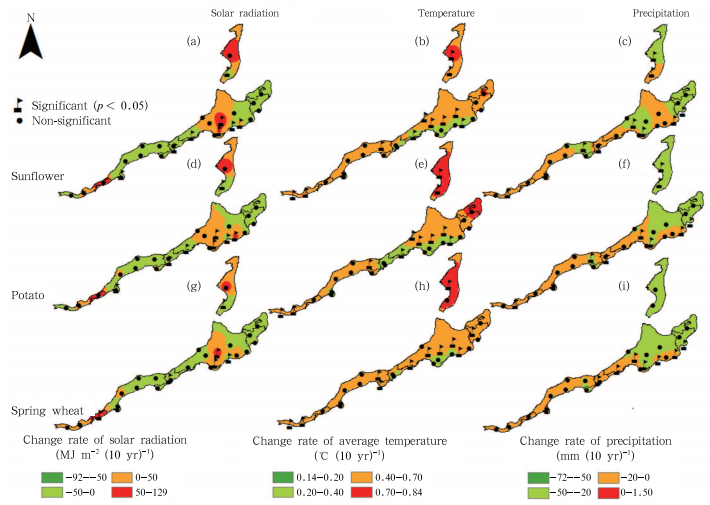
|
| Figure 2 Change rates per decade of (a, d, g) solar radiation (MJ m-2), (b, e, h) average temperature (℃), and (c, f, i) precipitation (mm) during the growing season of (a-c) sunflower, (d-f) potato, and (g-i) spring wheat in the APE region from 1981 to 2010. |
The light-temperature potential productivity of sunflower varied from 9200 to 16400 kg ha-1, the high-and low-value areas of which were concentrated in the southeastern and northeastern parts of APE, respectively (Fig. 3a). The light-temperature potential productivity for potato varied from 190750 to 237200 kg ha-1, with low values in northeastern and eastern APE (Fig. 3b). The light-temperature potential productivity for spring wheat varied from 16990 to 22700 kg ha-1, with high values in southeastern and southwestern APE (Fig. 3c). The light-temperature potential productivity of sunflower, positively correlated with the growing season average temperature (R2=0.86, p < 0.01) and growing season solar radiation (R2=0.52, p < 0.01), increased by 4.47% per decade across the study area. This suggested a higher positive impact of the increase in temperature than the negative impact of the decrease in solar radiation on the light-temperature potential productivity of sunflower from 1981 to 2010. For potato, the light-temperature potential productivity was positively correlated with growing season solar radiation (R2=0.52, p < 0.01), but negatively correlated with growing season average temperature (R2=0.26, p < 0.05). Therefore, the decrease in solar radiation and increase in temperature led to a decline by 1.58% in the light-temperature potential productivity of potato. For spring wheat, the light-temperature potential productivity was only significantly and positively correlated with growing season solar radiation (R2=0.57, p < 0.01). Therefore, the decline in solar radiation decreased the light-temperature potential productivity of spring wheat by 0.59% per decade from 1981 to 2010. For sunflower, the sites with increased light-temperature potential productivity accounted for 96% of the total. For potato and spring wheat, the light-temperature potential productivity decreased at 74% and 44% of the study sites, respectively.

|
| Figure 3 (a-c) Light-temperature potential productivity (kg ha-1) and (d-f) its change rate (kg ha-1 (10 yr)-1) for (a, d) sunflower, (b, e) potato, and (c, f) spring wheat. |
The climate-soil potential productivity varied from 2120 to 6350 kg ha-1 for sunflower (Fig. 4a), from 28500 to 93700 kg ha-1 for potato (Fig. 4b), and from 1960 to 6760 kg ha-1 for spring wheat (Fig. 4c), with high-value areas in eastern, northeastern and southwestern APE. The climate-soil potential productivity was positively correlated with growing season precipitation (R2=0.63, p < 0.01 for potato; R2=0.73, p < 0.01 for spring wheat), but negatively correlated with growing season average temperature (R2=0.45, p < 0.01 for potato; R2=0.32, p < 0.05 for spring wheat). For sunflower, the climate-soil potential productivity was only positively correlated with growing season precipitation (R2=0.28, p < 0.05). Due to the significant increase in growing season average temperature but insignificant change in growing season precipitation, the climate-soil potential productivity increased by 0.21% per decade for sunflower but decreased by 8.20% and 7.82% per decade for potato and spring wheat, respectively, across APE.
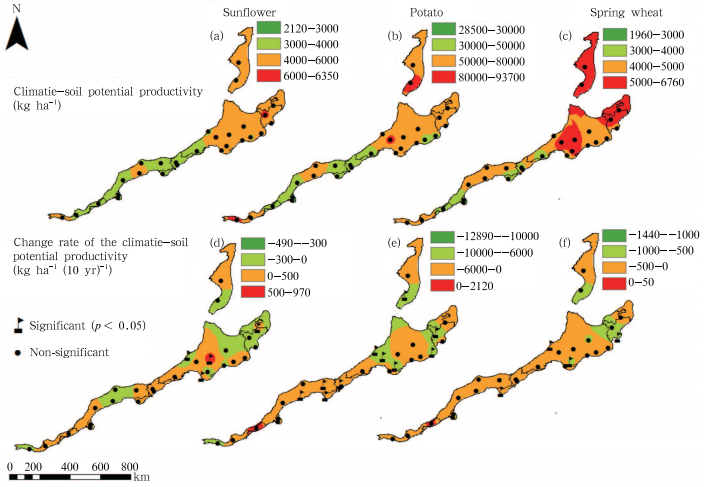
|
| Figure 4 (a-c) Climate-soil potential productivity (kg ha-1) and (d-f) its change rate (kg ha-1 (10 yr)-1) for (a, d) sunflower, (b, e) potato, and (c, f) spring wheat. |
The gaps between the light-temperature potential productivity and the climate-soil potential productivity varied from 5100 to 13080 kg ha-1 for sunflower, from 112400 to 188400 kg ha-1 for potato, and from 11900 to 19500 kg ha-1 for spring wheat (Figs. 5a-c). Low potential productivity gaps existed in northeastern APE, where growing season precipitation was higher than in other regions. Due to the higher increase in the light-temperature potential productivity than the climate-soil potential productivity, the potential productivity gaps increased by 590 kg ha-1 for sunflower across APE from 1981 to 2010 (Fig. 5d). However, the potential productivity gaps increased by 1470 kg ha-1 and 200 kg ha-1 per decade for potato and spring wheat, respectively, across APE from 1981 to 2010, owing to the higher decrease in the climate-soil potential productivity than the light-temperature potential productivity (Figs. 5e and 5f). The largest increase in the potential productivity gaps for the three crops occurred in the northeastern and mid-eastern APE regions. The above results showed that increasing temperature enlarged the gaps between the light-temperature potential productivity and the climate-soil potential productivity at 96%, 56%, and 59% of the study sites for sunflower, potato, and spring wheat, respectively.
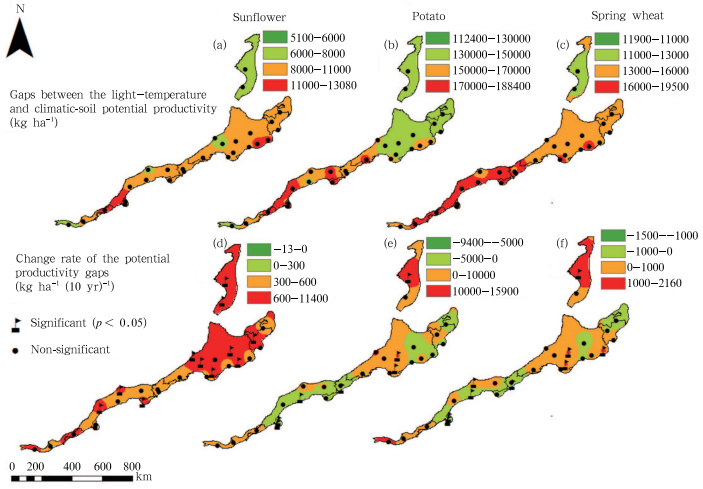
|
| Figure 5 (a-c) Gaps between the light-temperature and climate-soil potential productivity (kg ha-1) and (d-f) their change rates (kg ha-1 (10yr)-1) for (a, d) sunflower, (b, e) potato, and (c, f) spring wheat. |
The climate suitability ranged from 0.67 to 0.79 for sunflower (Fig. 6a), from 0.70 to 0.81 for potato (Fig. 6b), and from 0.59 to 0.73 for spring wheat (Fig. 6c). Although the climate suitability for potato was the highest among the three crops, it had been decreasing at 89% of the study sites since the 1980s. The climate suitability for spring wheat was the lowest among the three crops and decreased at 89% of the study sites from 1981 to 2010. However, the climate suitability for sunflower showed an increasing trend at 63% of the study sites from 1981 to 2010, suggesting that climate change had a positive impact on sunflower but a negative impact on potato and spring wheat across APE.
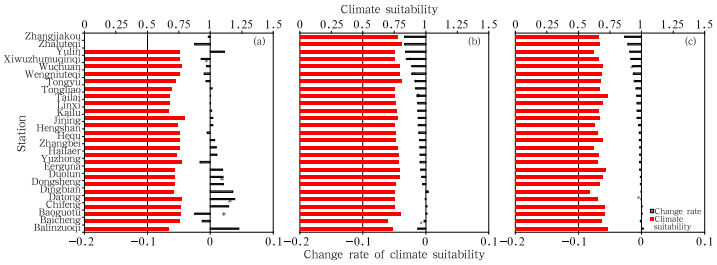
|
| Figure 6 Climate suitability (upper x-axis) and its change rate (lower x-axis) in the APE region for (a) sunflower, (b) potato, and (c) spring wheat. Asterisks indicate statistical significance at p < 0.05. |
Our study reveals that the light-temperature potential productivity increased for sunflower but decreased for potato and spring wheat across the APE region during the study period. Meanwhile, the climate-soil potential productivity increased by 0.21% for sunflower but decreased by 8.20% and 7.82% per decade for potato and spring wheat, respectively, after the 1980s. Climate change during 1981-2010 broadened the gaps between the light-temperature and climate-soil potential productivity for sunflower, potato and spring wheat in the APE region. The climate change during the past 30 years has led to a decrease in the climate suitability for potato and spring wheat, but an increase in the climate suitability for sunflower. Our findings suggest that the sown area of sunflower should be increased compared with that of potato and spring wheat in this region under future climate warming.
High crop diversity in the APE region could help ensure yield stability under harsh climate conditions. Therefore, farmers in the study area are accustomed to planting multiple crops in a season in different fields. Since the mid-1990s, the sown area of potato and sunflower has been increasing, while that of spring wheat has decreased obviously in the APE region (Fig. 7). Our study investigated the impact of climate change during the past 30 years on the potential productivity, the potential productivity gaps, and the climatic suitability for sunflower, potato, and spring wheat to assist with future decisions regarding plant structure distribution in the APE region of North China.

|
| Figure 7 Changes in the sown areas of staple crops in the APE region from 1981 to 2010. |
The average light-temperature potential productivity of potato in the study area was 2.09×105 kg ha-1, which is much higher than the average value of 0.94×105 kg ha-1 in subtropical SWC (He et al., 1998), because of the lower growing season temperature in the APE region. It is also much higher than the av erage value of 1.1×105 kg ha-1 in Chile (Haverkort et al., 2014), because of the higher harvest index used in our study. Furthermore, the climate-soil potential productivity of sunflower and spring wheat in the APE region of North China is much lower than that in Europe, owing to the shorter frost-free period in the study area (Harrison and Butterfield, 1996). In general, the actual highest yield could reach 80% of the potential yield calculated by crop growth dynamical statistical methods and crop growth models (Grassini et al., 2011). Comparison between the reported actual highest yield and the ratio of actual highest yield to the light-temperature potential productivity of stable crops in the APE region showed that the reported actual highest yield has reached and even exceeded the light-temperature potential productivity calculated by our study (Table 6), which suggests that crop growth dynamical statistical methods could be used as a tool for estimating theoretical crop potential productivity.

|
Our results showed that the light-temperature potential productivity increased for sunflower but decreased for potato and spring wheat across the APE region. The climate-soil potential productivity increased by 0.21% for sunflower but decreased by 8.20% and 7.82% per decade for potato and spring wheat, respectively, after the 1980s. The rates of decrease were sharper than those of potato and spring wheat (0.13% and 0.8%, respectively) in Europe (Supit et al., 2010), due to the more significant changes in temperature and precipitation in the study area. Figure 8 shows the observed actual yield, the climatic yield by detrending the actual yield with a 5-yr moving average, and the change trends in climatic yields of staple crops in APE at typical sites from 1981 to 2010. The observed crop yield showed an increasing trend at most of sites, caused by the use of new modern cultivars together with improved agronomic management techniques (Xiong et al., 2014; He et al., 2015; Mi et al., 2015). The change trend in climatic yields was similar to that of the climate-soil potential productivity calculated in our study, indicating that the change in climate-soil potential productivity could reflect the impact of climate change on crop yield in the APE region.
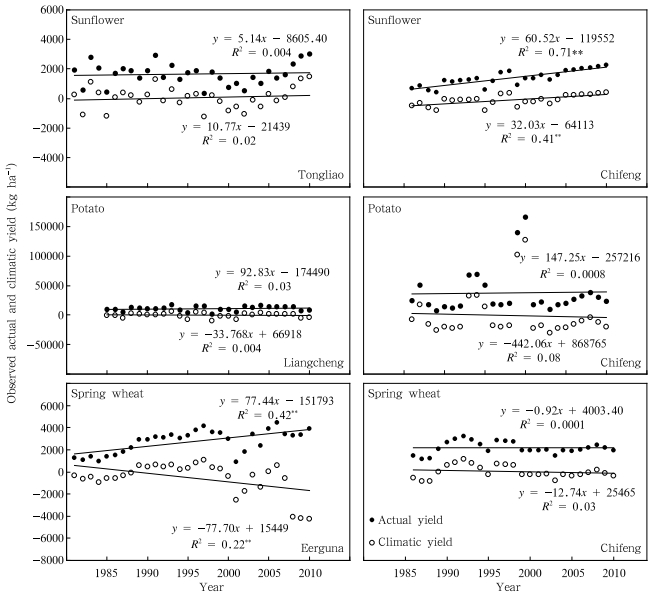
|
| Figure 8 The observed actual yield, climatic yield, and change trends in climatic yields of staple crops at typical sites in the APE region from 1981 to 2010 (** denotes results significant at p < 0.01). |
Climate change during 1981-2010 broadened the gaps between the light-temperature and climate-soil potential productivity for sunflower, potato, and spring wheat in the APE region. The results were similar to those of several other crops in a larger number of studies (He et al., 2014; Wang et al., 2014). In other climatic regions, such as Northeast China, the Huang-Huai-Hai Plain, and SWC, there is great potential to increase the crop potential productivity by increasing irrigation (Albersen et al., 2002; Wang et al., 2012; He et al., 2014). However, this is an unrealistic approach in the APE region of North China because of the low annual precipitation and low availability of surface and ground water (Xia et al., 2010). In fact, the regional average crop yield has not reached the climatic potential productivity due to below-optimum crop management and inferior soil fertility. Although many studies have focused on enhancing soil fertility in this region, it is difficult to achieve for the whole region due to the low precipitation and soil weathering (Pan et al., 2003).
Our study found that the climate change during the past 30 years led to a decrease in the climate suitability for potato and spring wheat, but an increase in for sunflower. Sensitivity analysis showed that the light-temperature potential productivity and climaticsoil potential productivity decreased for potato and spring wheat but increased for sunflower, with increases in temperature by 1, 2, and 3℃ (Table 7). The sensitivity of the climate-soil potential productivity to precipitation change showed spring wheat to be the most sensitive, followed by potato and sunflower (Table 8). The results suggest that the sown area of sunflower should be increased to adapt to future climate warming and drying in this region.

|

|
Our study analyzed the impact of climate change on crop production with a crop growth dynamics statistical method. The method is simple and feasible for evaluating the crop potential productivity in a large area. However, it could not be used to unravel the relative contribution of climate and non-climatic factors to crop production. In further research, crop growth models should be used to explore the interactive impact of changes in climate, crop varieties, and agronomic management on crop production in the APE region of North China, as has been successfully used in agricultural production in the North China Plain and Northeast China.
Acknowledgments: We would like to thank China Meteorological Administration for providing the historical climate data and agro-meteorological data. The authors acknowledge the anonymous referees for their valuable comments.| Albersen, P., G. Fischer, M. A. Keyzer, et al., 2002:Es-timation of Agricultural Production Relations in the LUC Model for China. International Institute for Applied Systems Analysis Press, Laxenburg, Aus-tria, 60 pp. |
| Allen R. G., Pereira L. S., Rates D., et al,1998: Crop Evapotranspiration-Guidelines for Computing Crop Water Requirements. . |
| Dong Zhiqiang, Pan Zhihua, An Pingli, et al ,2012: Re-sponses of growth period of spring wheat in north-ern ecotone to climate change:A case of Wuchuan County, Inner Mongolia, China. Progressus Inqui-sitiones de Mutatione Climatis , 8 , 265–271. |
| Du Bin, Qu Zhongyi, Yu Jian, et al ,2014: Experimental study on crop coefficient under mulched drip irriga-tion in Hetao Irrigation District of Inner Mongolia. Journal of Irrigation and Drainage , 33 , 16–20. |
| Duan Yu, Tuo Debao, Zhao Peiyi, et al ,2013: Crops caloric value and adjustment of planting structure in rainfed farmland of North Yinshan Mountian area, Inner Mongolia. Journal of Arid Land Re-sources and Environment , 27 , 153–157. |
| Gou Fang, Zhang Lizhen, Dong Wanlin, et al ,2012: Simulation model for the crop development stages in sunflower-potato intercropping. Chinese Journal of Applied Ecology , 23 , 2773–2778. |
| Grassini P., Thorburn J., Burr C., et al ,2011: High-yield irrigated maize in the western U. S. Corn Belt. I:On-farm yield, yield potential, and impact of agronomic practices. Field Crops Research , 120 , 142–150. |
| DOI:10.3354/cr007225 Harrison P. A., Butterfield R. E. ,1996: Effects of climate change on Europe-wide winter wheat and sunflower productivity. Climate Res. , 7 , 225–241. DOI:10.3354/cr007225 |
| DOI:10.1007/s11540-014-9250-8 Haverkort A. J., Sandaña P., Kalazich J. ,2014: Yield gaps and ecological footprints of potato production systems in Chile. Potato Research , 57 , 13–31. DOI:10.1007/s11540-014-9250-8 |
| DOI:10.1111/j.1439-037X.1998.tb00376.x He W., Struik P. C., Wang J., et al ,1998: Potential and actual yields of potato at different elevations and in different seasons in subtropical Southwest China. J. Agronomy Crop Sci. , 180 , 93–99. DOI:10.1111/j.1439-037X.1998.tb00376.x |
| DOI:10.1007/s13351-014-4047-x He Di, Wang Jing, Dai Tong, et al ,2014: Impact of climate change on maize potential productivity and the potential productivity gap in Southwest China. J. Meteor. Res. , 28 , 1155–1167. DOI:10.1007/s13351-014-4047-x |
| He Ling, He Wenshou, Ren Rang, et al., 2015:Effect of water-fertilizer coupling on oilseed sunflower in the drought region of Ningxia. Water Saving Irrigation, 16-20.(in Chinese) |
| Higgins, G. M., A. H.Kassam, L. Naiken, et al., 1982:Po-tential Population Supporting Capacities of Lands in the Developing World. Food and Agriculture Orga-nization of the United Nations, Roma, 139 pp. |
| Hou Qiong, Guo Ruiqing, Yang Litao ,2009: Cli-mate change and its impact on main crops in Inner Mongolia. Chinese J. Agrometeor. , 30 , 560–564. |
| Hou Xuehui, Niu Zheng, Gao Shuai, et al ,2013: Mon-itoring vegetation phenology in farming-pastoral zone using SPOT-VGT NDVI data. Transactions of the Chinese Society of Agricultural Engineering , 29 , 142–150. |
| Hu Qi, Pan Xuebiao, Yang Ning ,2015: Suitability of rainwater harvesting technology for potato farmland ridge and furrow in northern agro-pastoral zone of China. Arid Land Geography , 38 , 585–591. |
| Huang Bingwei,1985: Agricultural Productive Potentiality-Photosynthetic Potential in China. Beijing, China: Sci-ence Press. |
| Lacatusu R., Lacatusu A. R. ,2011: Complex in-dicator for assessing soil fertility. Res. J. Agricult. Sci. , 43 , 95–101. |
| Li Kenan, Yang Xiaoguang, Liu Zhijuan, et al ,2010: Analysis of the potential influence of global climate change on cropping systems in China. Ⅲ:The change characteristics of climatic resources in north-ern China and its potential influence on cropping systems. Scientia Agricultura Sinica , 43 , 2088–2097. |
| Liu Honglai, Wang Yimeng, Dou Xiao, et al ,2009: Progress and perspective of agro-pasturage ecotone. Acta Ecologiva Sinica , 29 , 4420–4425. |
| DOI:10.1016/j.fcr.2013.04.022 Liu L. L., Zhu Y., Tang L., et al ,2013: Impacts of climate changes, soil nutrients, variety types and management practices on rice yield in East China:A case study in the Taihu region. Field Crops Re-search , 149 , 40–48. DOI:10.1016/j.fcr.2013.04.022 |
| Liu Z. J., Hubbard K. G., Lin X. M., et al ,2013: Neg-ative effects of climate warming on maize yield are reversed by the changing of sowing date and cultivar selection in Northeast China. Global Change Biol-ogy , 19 , 3481–3492. |
| DOI:10.1016/j.ecolmodel.2005.11.030 Lobell D. B., Ortiz-Monasterio J. I. ,2006: Regional importance of crop yield constraints:Linking simu-lation models and geostatistics to interpret spatial patterns. Ecological Modelling , 196 , 173–182. DOI:10.1016/j.ecolmodel.2005.11.030 |
| DOI:10.1146/annurev.environ.041008.093740 Lobell D. B., Gassman K. G., Field C. B. ,2009: Crop yield gaps:Their importance, magnitudes, and causes. Annual Review of Environment and Re-sources , 34 , 179–204. DOI:10.1146/annurev.environ.041008.093740 |
| DOI:10.1016/j.agrformet.2015.02.008 Lv S., Yang X. G., Lin X. M., et al ,2015: Yield gap simu-lations using ten maize cultivars commonly planted in Northeast China during the past five decades. Agricultural and Forest Meteorology , 205 , 1–10. DOI:10.1016/j.agrformet.2015.02.008 |
| Ma Shuqing, Guo Shunji ,1995: The analysis of the potential productivity, exploitation, and utilization of climate-soil resources in Northeast China. Scien-tia Geographica Sinica , 15 , 243–252. |
| Mi Jian, Luo Qiyou, Gao Mingjie, et al ,2015: A sup-ply and demand equilibrium forecast of potato in medium and long term. Chinese J. Agricult. Re-sour. Regional Planning , 36 , 27–34. |
| Pan Zhihua, An Pingli, Liu Yaling, et al ,2003: Study on natural environment condition changes in the ecolog-ical system at the crossing belt (Wuchuan County) of agriculture and animal husbandry in northern China. Journal of China Agricultural Resources and Regional Planning , 24 , 37–41. |
| Pan Zhihua, Zhang Luyang, Chen Dongdong, et al ,2010: Research progress and thoughts about proper exploitation of field water potential productivity in farming-pastoral ecotone of Northern China. Jour-nal of Agricultural Science and Technology , 12 , 40–45. |
| DOI:10.1016/S1161-0301(98)00047-1 Porter J. R., Gawith M. ,1999: Temperatures and the growth and development of wheat:A review. European Journal of Agronomy , 10 , 23–26. DOI:10.1016/S1161-0301(98)00047-1 |
| Qiu Guowang, Zhao Yanxia, Wang Shili ,2001: Stud-ies on development of the interlock area of farming-pastoral region in northern China. China Popula-tion, Resources and Environment , 11 , 49–50. |
| Sun Jingsheng, Liu Zugui, Zhang Jiyang, et al ,2002: Crop coefficients of spring wheat in Windy Dust Area. Transactions of the CSAE , 18 , 55–58. |
| DOI:10.1016/j.agsy.2010.08.009 Supit I., van Diepen C. A., de Wit A. J. W., et al ,2010: Recent changes in the climatic yield potential of various crops in Europe. Agriculture Systems , 103 , 683–694. DOI:10.1016/j.agsy.2010.08.009 |
| Wang Jing'ai, Xu Xia, Liu Peifang ,1999: Land use and land carrying capacity in ecotone between agri-culture and animal husbandry in northern China. Resources Science , 21 , 19–24. |
| Wang Zongming, Zhang Bo, Zhang Shuqing, et al ,2005: Studies on agricultural climatic potential productiv-ity and natural resources utilization ratio in Songnen Plain of Heilongjiang Province. Chinese Journal of Agrometeorology , 26 , 1–6. |
| DOI:10.1007/s10584-011-0385-1 Wang J., Wang E. L., Yang X. G., et al ,2012: Increased yield potential of wheat-maize cropping system in the North China Plain by climate change adapta-tion. Climatic Change , 113 , 825–840. DOI:10.1007/s10584-011-0385-1 |
| DOI:10.1016/j.agrformet.2014.05.004 Wang J., Wang E. L., Yin H., et al ,2014: Declining yield potential and shrinking yield gaps of maize in the North China Plain. Agricultural and Forest Meteorology , 195-196 , 89–101. DOI:10.1016/j.agrformet.2014.05.004 |
| DOI:10.1016/j.fcr.2015.02.014 Wang J., Wang E. L., Yin H., et al ,2015: Differences between observed and calculated solar radiations and their impact on simulated crop yields. Field Crops Research , 176 , 1–10. DOI:10.1016/j.fcr.2015.02.014 |
| Wu Guishu ,2003: Research advance on the farming-grazing transitional zone in China. Journal of Sichuan Normal University (Natural Science) , 26 , 108–110. |
| Xia Zhechao, Pan Zhihua, Zhang Luyang, et al ,2010: Examining mechanisms of vegetation ecosystems degradation based on water in northern farming-pastoral zone:A case study on Wuchuan Country. Resources Science , 32 , 317–322. |
| DOI:10.1007/s10113-013-0418-6 Xiong W, Holman I. P., You L. Z., et al ,2014: Impacts of observed growing-season warming trends since 1980 on crop yields in China. Regional Environmen-tal Change , 14 , 7–16. DOI:10.1007/s10113-013-0418-6 |
| Yang Xiaoguang, Liu Zhijuan ,2014: Advances in research on crop yield gaps. Scientia Agricultura Sinica , 47 , 2731–2741. |
| DOI:10.1007/s11434-012-5135-x Yuan Bin, Guo Jianping, Ye Mingzhu, et al ,2012: Va-riety distribution pattern and climatic potential productivity of spring maize in Northeast China un-der climate change. Chin. Sci. Bull. , 57 , 3497–3508. DOI:10.1007/s11434-012-5135-x |
| Zhang Fuchun, Zhu Zhihui ,1990: Harvest index for various crops in China. Scientia Agricultura Sinica , 23 , 83–87. |
| Zhang Shuyuan, Li Jing, Ren Zhiyuan ,2011: Study on soil nutrients effect of grassland ecosystem in the farming-grazing ecotone in North Shaanxi. Journal of Shaanxi Normal University (Natural Science Edi-tion) , 39 , 75–80. |
| Zhao Yanxia, Qiu Guowang ,2001: A study of climate change impact on northern farming-pastoral region. Meteor. Mon. , 27 , 3–7. |
| Zhao Feng, Qian Huaisui, Jiao Shixing ,2003: The climatic suitability model of crop:A case study of winter wheat in Henan Province. Resources Science , 26 , 77–82. |
 2016, Vol. 30
2016, Vol. 30



